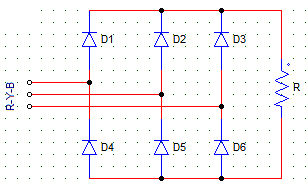Electrical Engineering (EE) Exam > Electrical Engineering (EE) Questions > A 3-phase 6-pulse diode rectifier is shown be...
Start Learning for Free
A 3-phase 6-pulse diode rectifier is shown below with phase sequence R-Y-B. The negative group of diodes (D4, D5, D6) conduct in sequence (from ωt = 0°)

- a)D4-D5-D6
- b)D5-D6-D4
- c)D6-D5-D4
- d)D6-D4-D5
Correct answer is option 'B'. Can you explain this answer?
| FREE This question is part of | Download PDF Attempt this Test |
Verified Answer
A 3-phase 6-pulse diode rectifier is shown below with phase sequence R...
The conduction sequence always depends on the phase sequence, which diode is conducting will depend upon which phase voltage is active at that moment.

|
Explore Courses for Electrical Engineering (EE) exam
|

|
Similar Electrical Engineering (EE) Doubts
A 3-phase 6-pulse diode rectifier is shown below with phase sequence R-Y-B. The negative group of diodes (D4, D5, D6) conduct in sequence (from ωt = 0°)a)D4-D5-D6b)D5-D6-D4c)D6-D5-D4d)D6-D4-D5Correct answer is option 'B'. Can you explain this answer?
Question Description
A 3-phase 6-pulse diode rectifier is shown below with phase sequence R-Y-B. The negative group of diodes (D4, D5, D6) conduct in sequence (from ωt = 0°)a)D4-D5-D6b)D5-D6-D4c)D6-D5-D4d)D6-D4-D5Correct answer is option 'B'. Can you explain this answer? for Electrical Engineering (EE) 2024 is part of Electrical Engineering (EE) preparation. The Question and answers have been prepared according to the Electrical Engineering (EE) exam syllabus. Information about A 3-phase 6-pulse diode rectifier is shown below with phase sequence R-Y-B. The negative group of diodes (D4, D5, D6) conduct in sequence (from ωt = 0°)a)D4-D5-D6b)D5-D6-D4c)D6-D5-D4d)D6-D4-D5Correct answer is option 'B'. Can you explain this answer? covers all topics & solutions for Electrical Engineering (EE) 2024 Exam. Find important definitions, questions, meanings, examples, exercises and tests below for A 3-phase 6-pulse diode rectifier is shown below with phase sequence R-Y-B. The negative group of diodes (D4, D5, D6) conduct in sequence (from ωt = 0°)a)D4-D5-D6b)D5-D6-D4c)D6-D5-D4d)D6-D4-D5Correct answer is option 'B'. Can you explain this answer?.
A 3-phase 6-pulse diode rectifier is shown below with phase sequence R-Y-B. The negative group of diodes (D4, D5, D6) conduct in sequence (from ωt = 0°)a)D4-D5-D6b)D5-D6-D4c)D6-D5-D4d)D6-D4-D5Correct answer is option 'B'. Can you explain this answer? for Electrical Engineering (EE) 2024 is part of Electrical Engineering (EE) preparation. The Question and answers have been prepared according to the Electrical Engineering (EE) exam syllabus. Information about A 3-phase 6-pulse diode rectifier is shown below with phase sequence R-Y-B. The negative group of diodes (D4, D5, D6) conduct in sequence (from ωt = 0°)a)D4-D5-D6b)D5-D6-D4c)D6-D5-D4d)D6-D4-D5Correct answer is option 'B'. Can you explain this answer? covers all topics & solutions for Electrical Engineering (EE) 2024 Exam. Find important definitions, questions, meanings, examples, exercises and tests below for A 3-phase 6-pulse diode rectifier is shown below with phase sequence R-Y-B. The negative group of diodes (D4, D5, D6) conduct in sequence (from ωt = 0°)a)D4-D5-D6b)D5-D6-D4c)D6-D5-D4d)D6-D4-D5Correct answer is option 'B'. Can you explain this answer?.
Solutions for A 3-phase 6-pulse diode rectifier is shown below with phase sequence R-Y-B. The negative group of diodes (D4, D5, D6) conduct in sequence (from ωt = 0°)a)D4-D5-D6b)D5-D6-D4c)D6-D5-D4d)D6-D4-D5Correct answer is option 'B'. Can you explain this answer? in English & in Hindi are available as part of our courses for Electrical Engineering (EE).
Download more important topics, notes, lectures and mock test series for Electrical Engineering (EE) Exam by signing up for free.
Here you can find the meaning of A 3-phase 6-pulse diode rectifier is shown below with phase sequence R-Y-B. The negative group of diodes (D4, D5, D6) conduct in sequence (from ωt = 0°)a)D4-D5-D6b)D5-D6-D4c)D6-D5-D4d)D6-D4-D5Correct answer is option 'B'. Can you explain this answer? defined & explained in the simplest way possible. Besides giving the explanation of
A 3-phase 6-pulse diode rectifier is shown below with phase sequence R-Y-B. The negative group of diodes (D4, D5, D6) conduct in sequence (from ωt = 0°)a)D4-D5-D6b)D5-D6-D4c)D6-D5-D4d)D6-D4-D5Correct answer is option 'B'. Can you explain this answer?, a detailed solution for A 3-phase 6-pulse diode rectifier is shown below with phase sequence R-Y-B. The negative group of diodes (D4, D5, D6) conduct in sequence (from ωt = 0°)a)D4-D5-D6b)D5-D6-D4c)D6-D5-D4d)D6-D4-D5Correct answer is option 'B'. Can you explain this answer? has been provided alongside types of A 3-phase 6-pulse diode rectifier is shown below with phase sequence R-Y-B. The negative group of diodes (D4, D5, D6) conduct in sequence (from ωt = 0°)a)D4-D5-D6b)D5-D6-D4c)D6-D5-D4d)D6-D4-D5Correct answer is option 'B'. Can you explain this answer? theory, EduRev gives you an
ample number of questions to practice A 3-phase 6-pulse diode rectifier is shown below with phase sequence R-Y-B. The negative group of diodes (D4, D5, D6) conduct in sequence (from ωt = 0°)a)D4-D5-D6b)D5-D6-D4c)D6-D5-D4d)D6-D4-D5Correct answer is option 'B'. Can you explain this answer? tests, examples and also practice Electrical Engineering (EE) tests.

|
Explore Courses for Electrical Engineering (EE) exam
|

|
Suggested Free Tests
Signup for Free!
Signup to see your scores go up within 7 days! Learn & Practice with 1000+ FREE Notes, Videos & Tests.


















